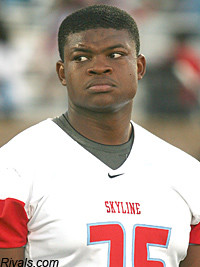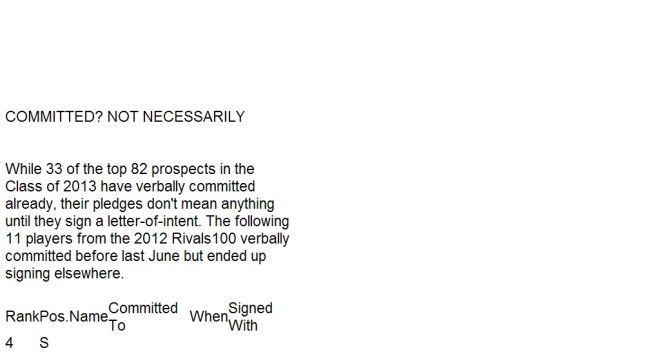Junior Days have class of 2013 off to fast start

Almost a full year before Dallas (Texas) Skyline defensive tackle Kerrick Huggins needed to sign his letter of intent, the pressure of the recruiting process already was getting to him.
The constant calls. The complications. It was all too much.
Advertisement
So when Huggins found a school that had what he wanted, the Rivals250 recruit saw no reason to delay his decision. Huggins committed to Texas A&M two weeks ago and breathed one huge sigh of relief.
"I felt like I had a 10-pound weight off my chest," said Huggins, the No. 154 prospect in the 2013 recruiting class.
A growing number of Huggins' peers can relate to that feeling.
National Signing Day for 2012 was less than a month ago, yet 33 of the nation's top 82 prospects for 2013 already have verbally committed.
The commitment process seemingly speeds up with each passing year. Now it's more accelerated than ever.
"If we were going 65 miles an hour last year, we're going 85 now," Rivals.com national recruiting analyst Mike Farrell said.
And it could lead to a few speed bumps as we move closer to Signing Day 2013.
This trend toward early commitments likely will result in more switches. Nearly one-third of the players in the 2012 Rivals100 who committed before June ended up signing elsewhere.
Yet that doesn't matter to high school prospects fed up with the distractions of recruiting. They continue to commit earlier and earlier.
Of course, they're also being tempted to commit as soon as possible.
For many years, college football powers have gathered their top junior targets on campus in a particular January, February or March weekend. Junior Days used to be the event that was a starting point in the recruiting process. Now it's when many schools try to close the deal.
Texas A&M has collected seven verbal commitments and Florida has received six commitments since holding their Junior Days last weekend. Michigan has obtained nine commitments since what essentially was the equivalent of a Junior Day event, as many of its top prospects visited campus last weekend to coincide with a home basketball game against Ohio State.
These schools are following the example of Texas, which annually puts together the vast majority of its recruiting class several months before Signing Day. Auburn and Florida State are among the schools having their own Junior Day events this weekend.
"Junior Days are a tremendous atmosphere," Farrell said. "Kids commit at Junior Days more often than they do on official visits. You're getting all the kids together, getting them all in the same room and telling them, 'Stick with us and you can build this thing together.' They get hyped up. You're removed from football season, it's kind of a boring time and you buy into it. You get that sort of 'visit rush' more so than you do during the season.
"During the season, you have a football game on Friday night, then you take your official visit and then you have practice. There are a lot of things to distract you during the season. In February, there's nothing really going on. The kids get together and the coaches do a great job of selling them.''
That environment helped persuade Daytona Beach (Fla.) Mainland linebacker Quinton Powell to commit to Florida last weekend. Florida's Junior Day event gave the four-star recruit a chance to speak with Rivals100 linebacker Daniel McMillian and Rivals250 linebacker James Hearns, who already had committed to the Gators earlier this month.

"Over here [it] was like a family,'' Powell told InsideTheGators.com. "A lot of the commits brought me in like their brother, and I like that. I was looking for a place that felt like home, and that made this an easy choice."
Prospects also might believe that committing early can end some of the headaches that come with the recruiting process.
"It's great to be able to have that total relief and have that total solidarity," Wheaton (Ill.) St. Francis offensive tackle Kyle Bosch told TheWolverine.com last weekend after committing to Michigan.
"I know that if I committed now, I won't have to be worried about as many phone calls, e-mails, Facebook, all that crazy stuff that goes on in recruiting. Now I can focus on being a better leader, better football player and better son. The recruiting stuff definitely has been grating me lately. It gets [to be] too much at a certain point.''
But is recruiting season really over for all these early commitments? Not necessarily.
Instead of allowing a prospect to end the process early, committing this soon often gives him more time to rethink his decision.
A look at the final 2012 Rivals100 reveals that 35 players from that list made their initial verbal commitments before June 2011. Eleven of them decommitted and signed with different schools.
Of the 65 Rivals100 recruits who made their decisions in June or later, only six switched their commitments. Of the 37 Rivals100 prospects who waited until at least September, only Monrovia (Calif.) defensive tackle Ellis McCarthy changed his mind. McCarthy committed to California during the Jan. 7 Army All-American Bowl, but he signed with UCLA after heralded recruiter Tosh Lupoi left the Golden Bears' staff.
"If you commit in February, you're going to be tempted to look around when the May evaluation period comes because all the other schools are coming in and saying, 'Why did you commit there so early? Come and take a look at our school.' '' Farrell said. "And then when December or late November comes around, they'll look at all these other kids who haven't committed and are taking these official visits and having fun.
"Some of these guys will feel left out. When they feel left out, they're going to start wanting attention, and they're not going to have to look too far for it. There are schools that will give it to them. And that's when they take the visit. They may have zero intention of going to another school. They'll think they're doing it for fun. And then the confusion starts.''

Click Here to view this Link.
Michigan, Florida and Texas A&M still have reason to feel confident about hanging on to their recent commitments.
Eleven of Michigan's 12 commitments for 2013 come from Michigan, Ohio or Illinois. All 10 of Florida's commitments and all 13 of Texas A&M's pledges are home-state products, while Texas also has gotten off to its usual fast start with six commitments from in-state prospects.
Conventional wisdom suggests that prospects who commit to a home-state school are less likely to switch - and of the 35 members of the 2013 Rivals100 who already have committed, 20 chose an in-state school.
Then again, that didn't stop 2012 five-star prospects Sacramento (Calif.) Grant safety Shaq Thompson or Lakewood (Ohio) St. Edward offensive tackle Kyle Kalis. Both signed with out-of-state schools after initially committing to home-state programs. Kalis flipped from Ohio State to Michigan, while Thompson switched from California to Washington.
Sure, outside factors played a factor in both decisions. Kalis decommitted after the resignation of former Ohio State coach Jim Tressel, while Thompson followed Lupoi from California to Washington. But they still provided evidence that committing early to an in-state school doesn't guarantee anything.
Thompson and Kalis were two of the 17 Rivals100 prospects to switch from their initial commitments, the highest total since the current version of Rivals.com started in 2002. Perhaps all these early commitments indicate this recruiting season will settle down after all the late switches that marked the 2012 cycle.
Or it may suggest just the opposite.
"It's just going to lead to more craziness and confusion than ever before," Farrell said. "Based on what I saw [last] weekend, I'm expecting 2013 to be the craziest year yet. ''
Steve Megargee is a national writer for Rivals.com. He can be reached at smegargee@rivals.com, and you can click here to follow him on Twitter.
[rl]